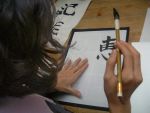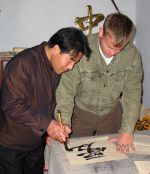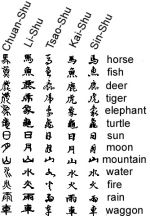Basic principles of hieroglyphic writing
Writing hieroglyphs is not that complicated as it may seem at first. Japanese hieroglyphs originate from the Chinese ones, for the Japanese writing was once borrowed from the Chinese language. If in Japanese a single hieroglyph can denote both a separate word the word collocations, in Chinese every hieroglyph stands for one word only.
In Chinese there are about 50, 000 hieroglyphs 10, 000 of which are frequently used. In Japanese they use about 2, 000 hieroglyphs.
All the hieroglyphs are written in accordance with the certain rules. The structural element of a hieroglyph is called a stroke. There are 14 such strokes in total. They differ from each other by the place they occupy in a hieroglyphic structure and curves. Thus, calligraphy of a hieroglyph is actually a certain succession of strokes inside it. It is rather unusual, but some hieroglyphs have not only several meanings but also several variants of writing.
The basic rules of hieroglyphic writing:
- When being written, a hieroglyph is placed into an imagined "square"
- A hieroglyph is written from top downward.
- A hieroglyph is written from the left to the right.
- A horizontal stroke is prior to a vertical one: in case of the intersection of several strokes in a hieroglyph.
- The central stroke in a hieroglyph consisting of three strokes will have priority over all the rest, and will be the first to be written.
- The vertical stroke which intersects the hieroglyph in its centre will be written after all others.
- The stroke from the left to the right is written after the stroke heading from the right to the left and from top downward.
The present rules of writing the hieroglyphs are basic for mastering the hieroglyphic writing. Nevertheless, practical hieroglyphic studies are much more efficient.
Styles of Writing Hieroglyphs.
Traditions of writing Chinese hieroglyphs are closely connected with development and formation of writing in China. We can speak about the following styles:
- Chuan-Shu (seal script) was used for stamp production.
- Li-Shu (clerical style) was used in official documents.
- Tsao-Shu is a cursive script.
- Kai-Shu (standard script) is still used in China today after more than 1.700 years. It is the main and official Chinese writing style.
- Sin-Shu (semi-cursive script) is a style in between Tsao-Shu and Kai-Shu.
First two styles were very popular in Ancient China. History of Japanese calligraphy is known to be closely connected with Chinese one. We can single out the following calligraphic styles of writing Japanese hieroglyphs:
All the calligraphic styles in Japan were based on interconnection of written text with esthetic pleasure. During the Edo Epoch (1603-1868) two decorative styles were widely used – Kabuki-Modzi and Dzoruri-Modzi. As a rule, they were used for show bills and programmes of Dzoruri and Kabuki theaters.
Styles of writing hieroglyphs of Chinese and Japanese calligraphy are not limited to the mentioned above, but they are the basic ones.
Back to listCalligraphy is a remedy and mental gymnastics.









